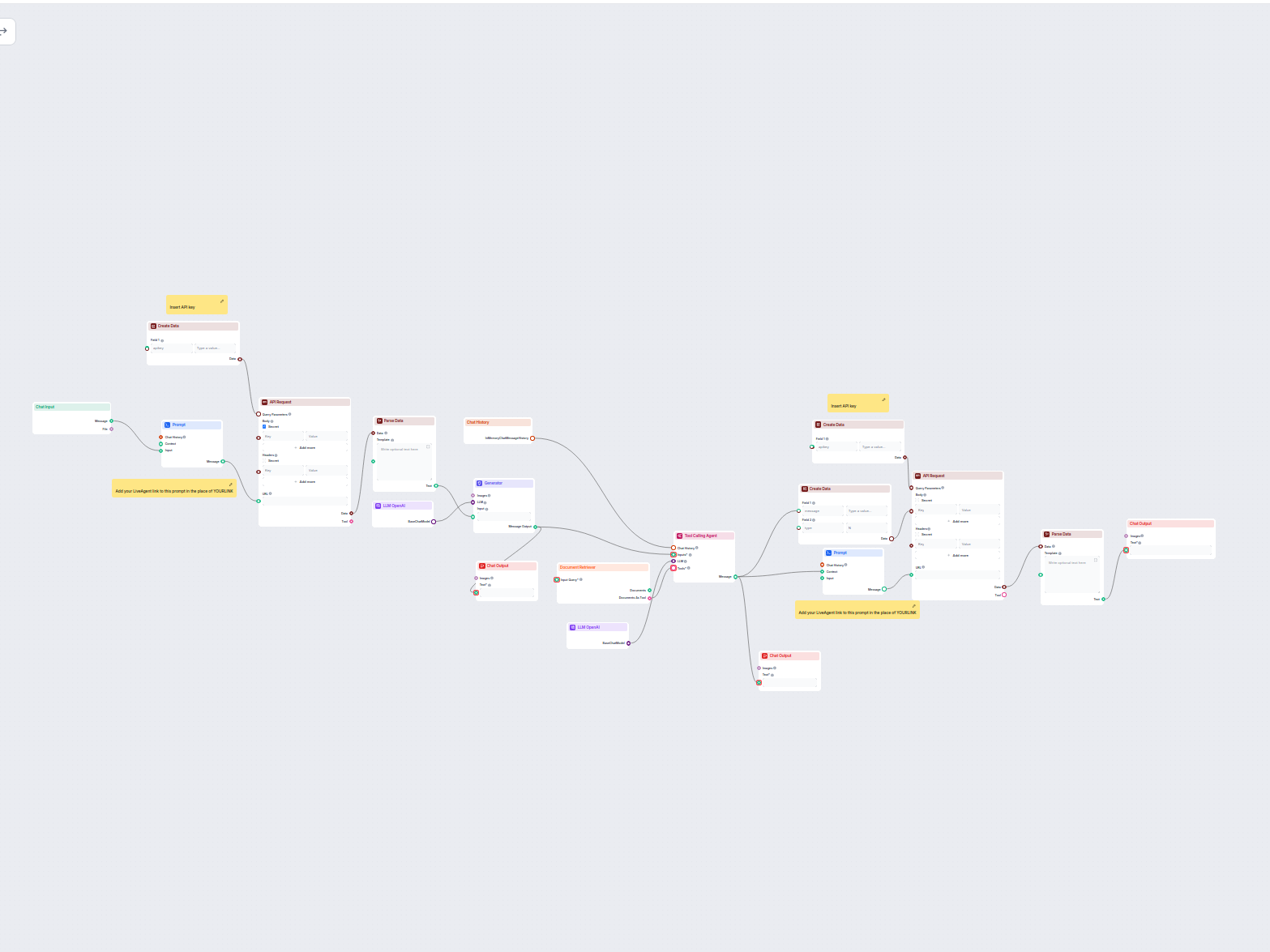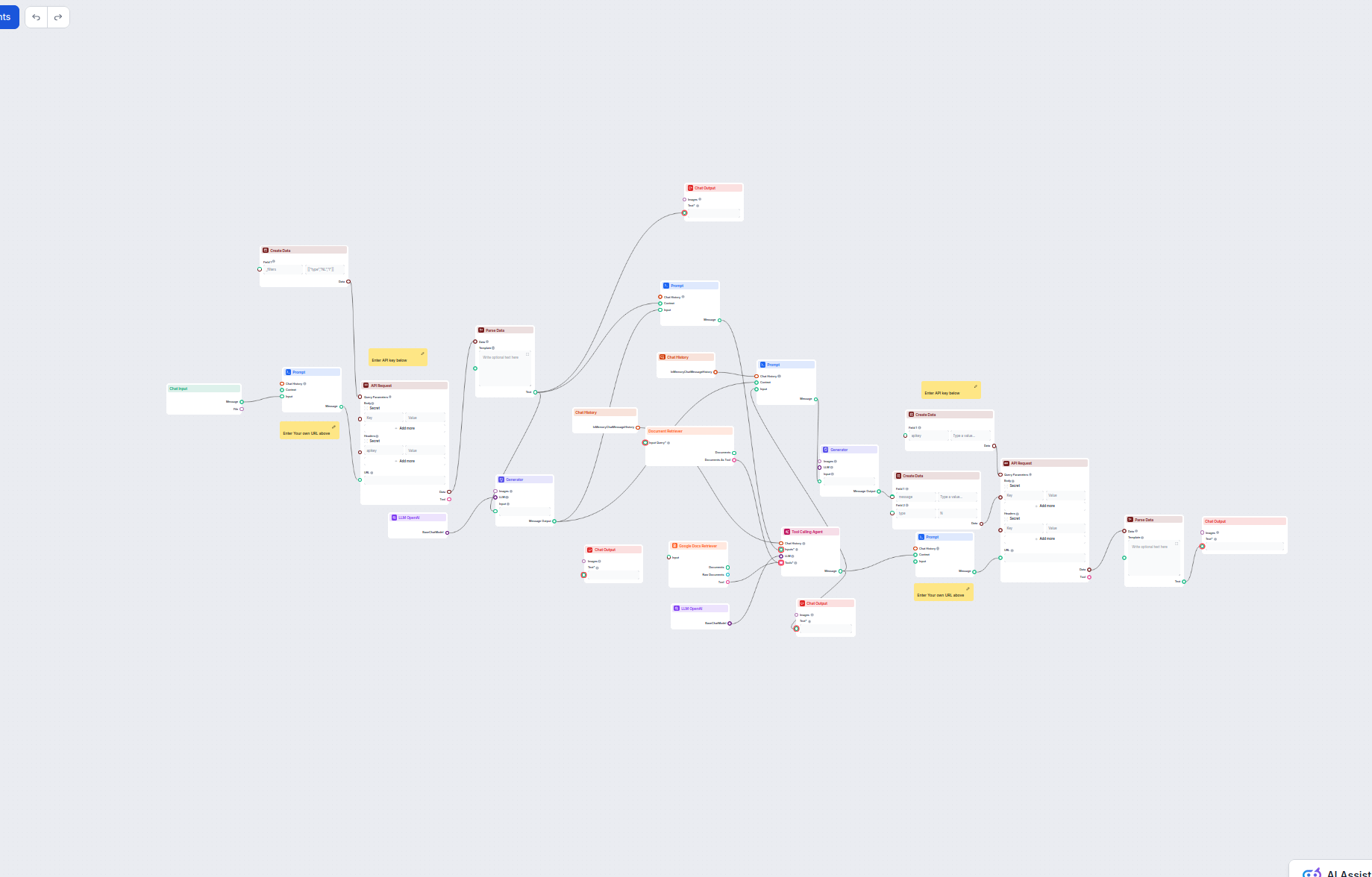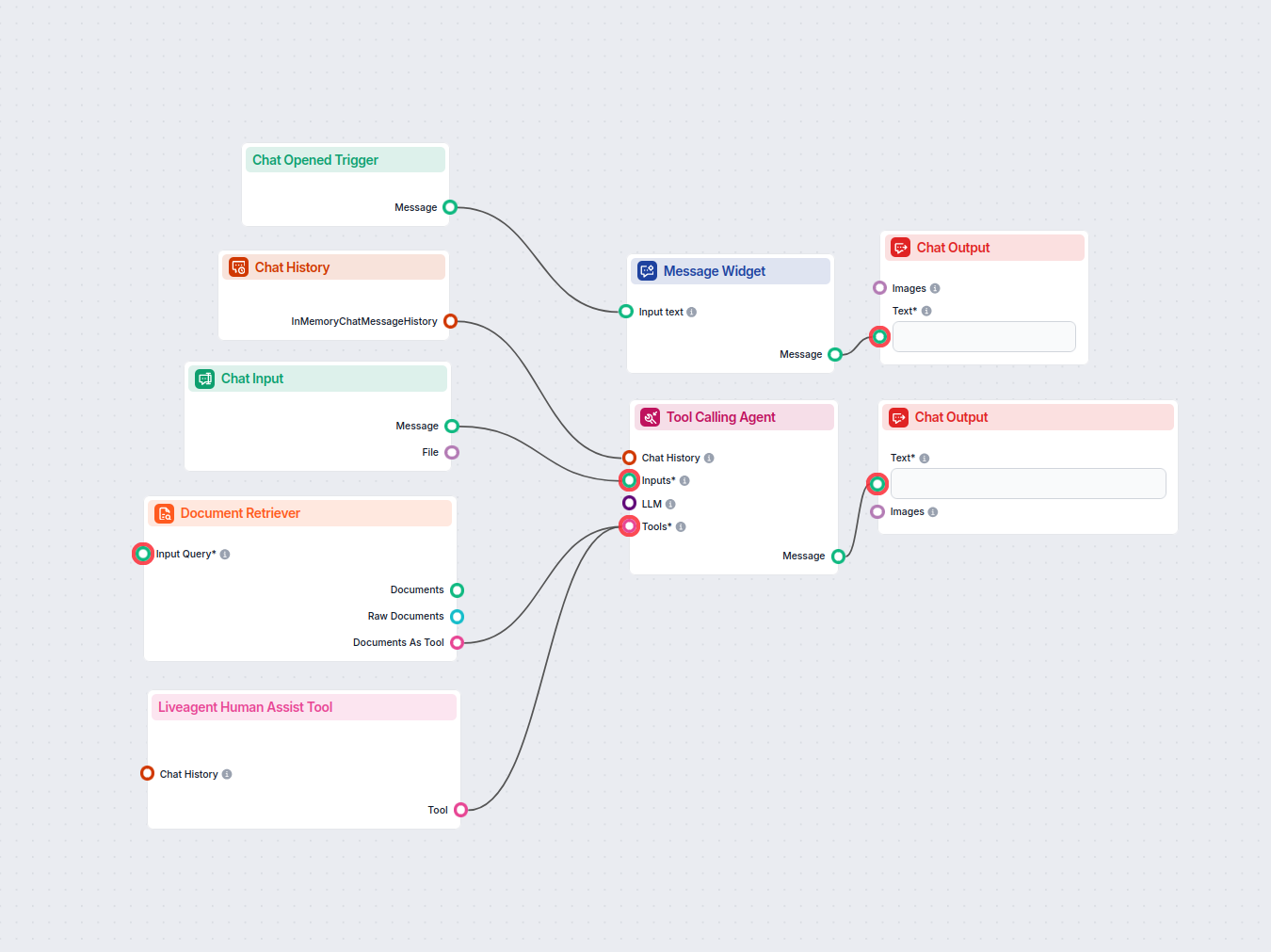Prompt
Create a prompt template with dynamic variables ({input}, {human_input}, {context}, {chat_history}, {system_message}, {all_input_variables}).
This workflow automates customer support for your company by integrating LiveAgent conversations, extracting relevant conversation data, generating responses using AI models, and retrieving knowledge base documents. The AI agent handles incoming support queries, enriches context from knowledge sources, and delivers concise, professional replies in a customer-friendly format.

Flows
Create a prompt template with dynamic variables ({input}, {human_input}, {context}, {chat_history}, {system_message}, {all_input_variables}).
Create a prompt template with dynamic variables ({input}, {human_input}, {context}, {chat_history}, {system_message}, {all_input_variables}).
Generate text using input prompt and selected LLM model.
A tool calling agent.
Below is a complete list of all components used in this flow to achieve its functionality. Components are the building blocks of every AI Flow. They allow you to create complex interactions and automate tasks by connecting various functionalities. Each component serves a specific purpose, such as handling user input, processing data, or integrating with external services.
The Chat Input component in FlowHunt initiates user interactions by capturing messages from the Playground. It serves as the starting point for flows, enabling the workflow to process both text and file-based inputs.
Learn how FlowHunt's Prompt component lets you define your AI bot’s role and behavior, ensuring relevant, personalized responses. Customize prompts and templates for effective, context-aware chatbot flows.
The Create Data component enables you to dynamically generate structured data records with a customizable number of fields. Ideal for workflows that require the creation of new data objects on the fly, it supports flexible field configuration and seamless integration with other automation steps.
Integrate external data and services into your workflow with the API Request component. Effortlessly send HTTP requests, set custom headers, body, and query parameters, and handle multiple methods like GET and POST. Essential for connecting your automations to any web API or service.
The Parse Data component transforms structured data into plain text using customizable templates. It enables flexible formatting and conversion of data inputs for further use in your workflow, helping to standardize or prepare information for downstream components.
FlowHunt supports dozens of text generation models, including models by OpenAI. Here's how to use ChatGPT in your AI tools and chatbots.
Explore the Generator component in FlowHunt—powerful AI-driven text generation using your chosen LLM model. Effortlessly create dynamic chatbot responses by combining prompts, optional system instructions, and even images as input, making it a core tool for building intelligent, conversational workflows.
Explore the Tool Calling Agent in FlowHunt—an advanced workflow component that enables AI agents to intelligently select and use external tools to answer complex queries. Perfect for building smart AI solutions that require dynamic tool usage, iterative reasoning, and integration with multiple resources.
FlowHunt's Document Retriever enhances AI accuracy by connecting generative models to your own up-to-date documents and URLs, ensuring reliable and relevant answers using Retrieval-Augmented Generation (RAG).
The Chat History component in FlowHunt enables chatbots to remember previous messages, ensuring coherent conversations and improved customer experience while optimizing memory and token usage.
Discover the Chat Output component in FlowHunt—finalize chatbot responses with flexible, multi-part outputs. Essential for seamless flow completion and creating advanced, interactive AI chatbots.
Flow description
This workflow is designed to automate and scale advanced customer support and knowledge retrieval tasks, making use of LLMs (Large Language Models), dynamic data creation, external API requests (such as LiveAgent), and automated document retrieval. It is especially useful for organizations seeking to streamline support processes, respond to customer queries with context-aware responses, and integrate knowledge-base lookups with external system interactions.
The workflow orchestrates these main steps:
| Step | Component | Purpose |
|---|---|---|
| 1 | Chat Input | Accepts user queries or messages |
| 2 | Prompt Template | Forms dynamic URLs for API requests, substituting user input and context into predefined templates |
| 3 | API Request | Sends HTTP requests (GET/POST) to external APIs (e.g., LiveAgent), including parameters and body as needed |
| 4 | Parse Data | Converts API responses (JSON/data) into plain text or structured prompts for LLM processing |
| 5 | LLM Generator | Uses an LLM (e.g., OpenAI GPT-4.1) to extract specific sections (e.g., “Preview”) from input data |
| 6 | Tool Calling Agent | An LLM agent that receives all context, history, and tools, and is guided by a custom system prompt |
| 7 | Document Retriever | Searches knowledge sources for relevant documents based on the user’s query |
| 8 | Chat Output | Presents the final answer or messages to the user |
YOURLINK in prompt templates with their actual LiveAgent instance URL.| Node Type | Main Role |
|---|---|
| Note | Reminders and instructions for configuration |
| Chat Input/Output | User interaction endpoints |
| Chat History | Provides context from previous interactions |
| Create Data | Dynamically builds API request data |
| Prompt Template | Generates query URLs or prompts |
| API Request | Interacts with external services |
| Parse Data | Transforms raw data for LLM consumption |
| LLM Generator | Extracts/Processes information using LLM |
| Document Retriever | Searches internal knowledge sources |
| Tool Calling Agent | Orchestrates tools and generates response |
This workflow is ideal for automating customer support, integrating with external ticketing or chat systems, and ensuring LLM-driven responses are always grounded in authoritative company knowledge. It can be the backbone of a scalable, intelligent support assistant ready for enterprise use.
We help companies like yours to develop smart chatbots, MCP Servers, AI tools or other types of AI automation to replace human in repetitive tasks in your organization.
This AI-powered workflow automates customer support by connecting user queries to company knowledge sources, external APIs (such as LiveAgent), and a language m...
This AI-powered workflow automates customer support by combining internal knowledge base search, Google Docs knowledge retrieval, API integration, and advanced ...
Automate your customer support with an AI chatbot that answers questions using your internal knowledge base and seamlessly connects users to a human agent via L...
Cookie Consent
We use cookies to enhance your browsing experience and analyze our traffic. See our privacy policy.



